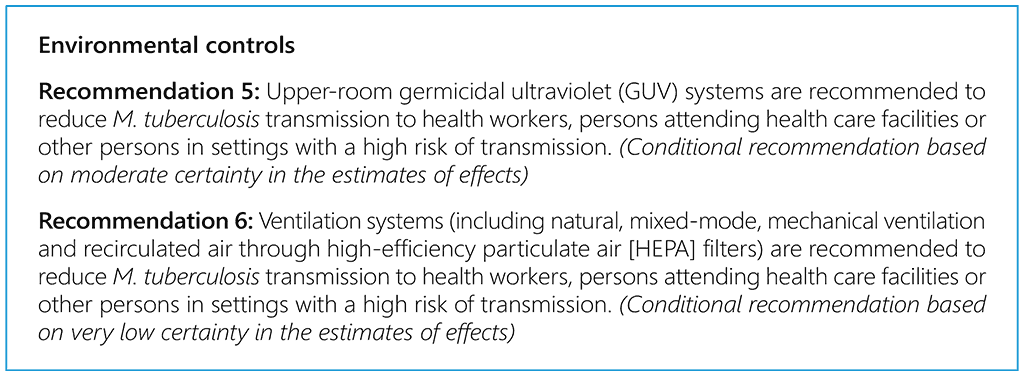Consolidated Guidelines
Executive summary
Worldwide, tuberculosis (TB) continues to be the most important cause of death from a single infectious microorganism.¹⁴ Although recent decades have witnessed increased efforts in the fight to end TB, fundamental gaps are hampering these efforts, particularly in resource-constrained settings and in settings with a high burden of disease.
How to use these guidelines
These guidelines have been developed to provide updated, evidence-informed recommendations on tuberculosis (TB) infection prevention and control (IPC) in the context of the global targets of the Sustainable Development Goals (SDGs) and the World Health Organization (WHO) End TB Strategy.
Definitions
General
Antimicrobial resistance (AMR) The loss of effectiveness of any anti-infective medicine, including antiviral, antifungal, antibacterial and antiparasitic medicines.
Grading of Recommendations Assessment, Development and Evaluation (GRADE) An approach to grading in health care that aims to overcome the shortcomings of current grading systems. For further information, see the GRADE website.¹
Annex 1. Recommendations in the WHO consolidated guidelines on tuberculosis: tuberculosis preventive treatment, second edition (2024) and in the previous edition (2020)
The key changes in the current second edition of these guidelines are highlighted in Box 1, after the Executive summary.
Table A1.1. Recommendations in the 2020 guidelines and recommendations in the current update (2024)
1.4 TB preventive treatment options
TPTs for an infection with M. tuberculosis strains presumed to be drug-susceptible can be broadly categorized into two types: monotherapy with isoniazid for at least 6 months (IPT) and treatment with regimens containing a rifamycin (rifampicin or rifapentine). IPT has been the most widely used form of TPT, but the shorter duration of rifamycin regimens presents a clear advantage, making these regimens increasingly preferred. TPT for MDR/RR-TB requires a different approach, primarily with levofloxacin.
1.3 Testing for TBI
Testing for TBI increases the certainty that individuals targeted for TPT will benefit better from it. There is, however, no gold standard test for diagnosing TBI. All the currently available tests – TST, IGRA and TBST – are indirect and require a competent immune response for a valid result. A positive test result by any one method is not by itself a reliable indicator of the risk of progression to TB disease. The evidence and the recommendations for TBI testing are discussed in this section.
References
- Getahun H, Matteelli A, Chaisson RE, Raviglione M. Latent Mycobacterium tuberculosis infection. N Engl J Med. 2015;372(22):2127–35. doi:10.1056/NEJMra1405427.
- Dodd PJ, Gardiner E, Coghlan R, Seddon JA. Burden of childhood tuberculosis in 22 high-burden countries: a mathematical modelling study. Lancet Glob Health. 2014;2(8):e453–9. doi:10.1016/S2214-109X(14)70245-1.
- Houben RMGJ, Dodd PJ. The global burden of latent tuberculosis infection: a re-estimation using mathematical modelling. PLoS Med. 2016;13(10):e1002152.
3. Research gaps
The review of evidence for the current update exposed additional knowledge gaps to those reported in other recent updates of the guidelines. Continued research on development and on implementation remains critical for many aspects of PMTPT (136). Some information can be collected from user feedback.
2. Monitoring and evaluation
Coverage of contact investigation and TPT among child contacts and people with HIV are two of the top 10 core indicators for monitoring implementation of the End TB Strategy (8). National TB and HIV programmes report data yearly to WHO and UNAIDS on progress in PMTPT in target populations (41,130). PMTPT should include monitoring and evaluation systems that are aligned with national TB patient monitoring and surveillance systems. They should include coverage of TPT with levofloxacin among contacts exposed to MDR/RR-TB.
Pagination
- Previous page
- Page 47
- Next page
 Feedback
Feedback

